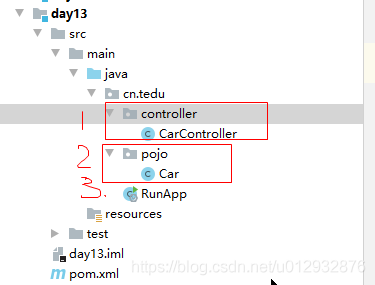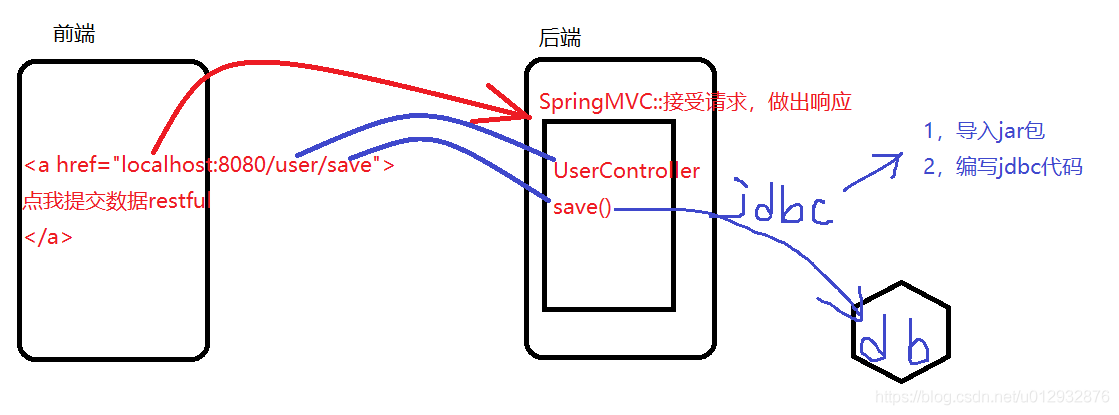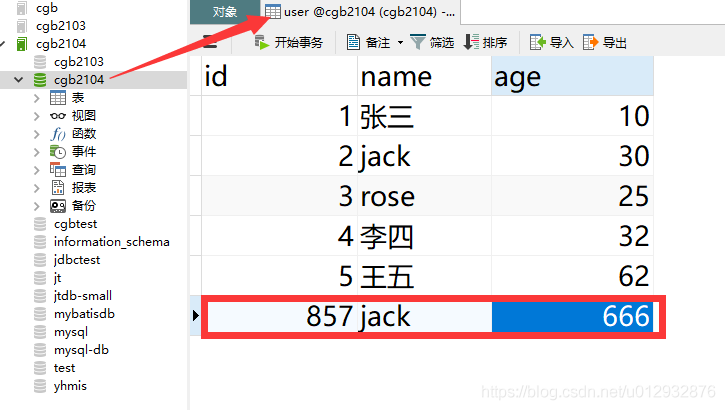一,创建day13的module
选中project-右键-new-module-选择maven-next-输入module名-finish
二,复习SpringMVC
–1,需求:访问/car/get ,获取汽车数据

–2,创建RunApp类
|
1
2
3
4
5
6
7
8
9
10
|
package cn.tedu;import org.springframework.boot.SpringApplication;import org.springframework.boot.autoconfigure.SpringBootApplication;//启动类@SpringBootApplicationpublic class RunApp { public static void main(String[] args) { SpringApplication.run(RunApp.class); }} |
–3,创建Car类
|
1
2
3
4
5
6
7
8
9
10
11
12
13
14
15
16
17
18
19
20
21
22
23
24
25
26
27
28
29
30
31
32
|
package cn.tedu.pojo;//Model用来封装数据public class Car { private int id; private String name; private double price; //Constructor构造方法,用来方便的new public Car(){} public Car(int id, String name, double price) { this.id = id; this.name = name; this.price = price; } public int getId() { return id; } public void setId(int id) { this.id = id; } public String getName() { return name; } public void setName(String name) { this.name = name; } public double getPrice() { return price; } public void setPrice(double price) { this.price = price; }} |
–4,创建CarController类
|
1
2
3
4
5
6
7
8
9
10
11
12
13
14
|
package cn.tedu.controller;//MVC里的C层,用来接受请求和做出响应(springmvc)import cn.tedu.pojo.Car;import org.springframework.web.bind.annotation.RequestMapping;import org.springframework.web.bind.annotation.RestController;@RestController//接受请求,并把json数据返回@RequestMapping("car") //规定了url地址的写法public class CarController { @RequestMapping("get") public Car get(){ Car c = new Car(10,"BMW",19.9); return c ; }} |
三,SpringMVC解析请求参数
SpringMVC框架,可以自动解析请求中,携带的参数。甚至可以直接封装成Java对象。而不必自己一个个解析参数。
–1,普通的GET提交
|
1
2
3
4
5
6
7
8
9
10
11
12
13
14
15
16
17
18
19
20
21
22
23
24
25
26
27
28
29
30
31
32
33
34
35
36
37
38
39
40
41
42
|
package cn.tedu.controller;//MVC里的C层,用来接受请求和做出响应(springmvc)import cn.tedu.pojo.Car;import org.springframework.web.bind.annotation.RequestMapping;import org.springframework.web.bind.annotation.RestController;@RestController//接受请求,并把json数据返回@RequestMapping("car") //规定了url地址的写法public class CarController { //SpringMVC框架解析请求中的参数 //http://localhost:8080/car/get5?id=10&name=BMW&price=9.9 @RequestMapping("get5") public void get5(Car c){//springmvc框架会把请求的参数,封装给car对象 System.out.println(c.getId()+c.getName()+c.getPrice()); } //http://localhost:8080/car/get4?id=10&name=BMW @RequestMapping("get4") public void get4(Integer id,String name){ //id是用来接受url里id的值,name用来接受url里name的值 System.out.println(id+name); } //http://localhost:8080/car/get3?id=10 @RequestMapping("get3")// public void get3(int id){ //参数是基本类型,访问这个方法必须带参数,否则有异常 public void get3(Integer id){//参数是引用类型,访问这个方法没带参数就是null System.out.println(id); } //自己解析请求中的参数 public void get2(){ String url="http://localhost:8080/car/get2?id=10&name=BMW&price=9.9"; //先按?切出来,取第二部分,再用&切出来参数名和参数值[id=10,name=BMW,price=9.9] String[] s = url.split("\\?")[1].split("&"); for (String ss : s) { String key = ss.split("=")[0]; String value = ss.split("=")[1] ; } } @RequestMapping("get") public Car get(){ Car c = new Car(10,"BMW",19.9); return c ; }} |
–2,RestFul提交
|
1
2
3
4
5
6
7
8
9
10
11
12
13
14
15
16
17
18
19
20
21
22
23
24
25
26
27
28
|
package cn.tedu.controller;import org.springframework.web.bind.annotation.PathVariable;import org.springframework.web.bind.annotation.RequestMapping;import org.springframework.web.bind.annotation.RestController;//对比,请求参数的不同获取方式:get/restful@RestController@RequestMapping("car2")public class CarController2 { //1.普通的get方式获取请求参数 //解析参数:http://localhost:8080/car2/get?id=10&name=BMW&age=10&sex=1 @RequestMapping("get") public String get(Integer id,String name,Integer age,Integer sex){// return id+name+age+sex ;//直接把结果展示在浏览器上 return "{'id':'"+id+"'}" ;//组织成json串给浏览器展示 } //2.restful方式获取请求参数:通过{}绑定地址中参数的位置 + 通过注解获取{???}的值 //解析参数:http://localhost:8080/car2/get2/10/BMW/10/1 @RequestMapping("get2/{id}/{name}/{x}/{y}") public void get2(@PathVariable Integer id, @PathVariable String name, @PathVariable String x, @PathVariable Integer y){ System.out.println(id); System.out.println(name); System.out.println(x); System.out.println(y); }} |
四,简单的前后端关联
–1,需求
点击页面的a,Get方式提交数据,交给框架解析参数
–2,创建html页面
|
1
2
3
4
5
6
7
8
9
10
11
|
<!DOCTYPE html><html> <head> <meta charset="utf-8"> <title>用get方式提交数据给服务器</title> </head> <body> <a href="http://localhost:8080/user/save?id=857&name=jack&age=666">点我提交数据get</a> <a href="http://localhost:8080/user/save2/857/jack/666">点我提交数据restful</a> </body></html> |
–3,创建UserController类,解析参数
|
1
2
3
4
5
6
7
8
9
10
11
12
13
14
15
16
17
18
19
20
21
22
23
|
package cn.tedu.controller;import org.springframework.web.bind.annotation.PathVariable;import org.springframework.web.bind.annotation.RequestMapping;import org.springframework.web.bind.annotation.RestController;@RestController@RequestMapping("user")public class UserController { //1. 解析get的请求参数 http://localhost:8080/user/save?id=857&name=jack&age=666 @RequestMapping("save") public void save(Integer id,String name,Integer age){ System.out.println(id+name+age); } //2. 解析restful的请求参数 http://localhost:8080/user/save2/857/jack/666 //get和restful的区别? //get的好处是数据都在地址栏拼接,restful的好处是相对安全 //restful主要是用来优化、简化get提交数据的写法 @RequestMapping("save2/{x}/{y}/{z}") public void save2(@PathVariable Integer x, @PathVariable String y, @PathVariable Integer z){ System.out.println(x+y+z); }} |
五,利用JDBC技术,把请求参数入库

–1,添加jdbc的依赖(修改pom.xml)
|
1
2
3
4
5
6
7
8
9
10
11
12
13
14
15
16
17
18
19
20
|
<?xml version="1.0" encoding="UTF-8"?><project xmlns="http://maven.apache.org/POM/4.0.0" xmlns:xsi="http://www.w3.org/2001/XMLSchema-instance" xsi:schemaLocation="http://maven.apache.org/POM/4.0.0 http://maven.apache.org/xsd/maven-4.0.0.xsd"> <parent> <artifactId>cgb2104boot01</artifactId> <groupId>cn.tedu</groupId> <version>0.0.1-SNAPSHOT</version> </parent> <modelVersion>4.0.0</modelVersion> <artifactId>day13</artifactId> <!--添加jar包的依赖--> <dependencies> <dependency> <groupId>mysql</groupId> <artifactId>mysql-connector-java</artifactId> <version>5.1.48</version> </dependency> </dependencies></project> |
–2,准备user表
|
1
2
3
4
5
|
CREATE TABLE `user` ( `id` int(3) default NULL, `name` varchar(10) default NULL, `age` int(2) default NULL) ENGINE=InnoDB DEFAULT CHARSET=utf8; |
–3,修改UserController类的save()
|
1
2
3
4
5
6
7
8
9
10
11
12
13
14
15
16
17
18
19
20
21
22
23
24
25
26
27
28
29
30
31
32
33
34
35
36
37
38
39
40
41
42
43
44
45
|
package cn.tedu.controller;import org.springframework.web.bind.annotation.PathVariable;import org.springframework.web.bind.annotation.RequestMapping;import org.springframework.web.bind.annotation.RestController;import java.sql.Connection;import java.sql.DriverManager;import java.sql.PreparedStatement;@RestController@RequestMapping("user")public class UserController { //1. 解析get的请求参数 http://localhost:8080/user/save?id=857&name=jack&age=666 @RequestMapping("save") public void save(Integer id,String name,Integer age) throws Exception {// System.out.println(id+name+age); /* 把解析出来的参数,利用jdbc技术入库*/ //注册驱动 Class.forName("com.mysql.jdbc.Driver"); //获取连接 String url ="jdbc:mysql:///cgb2104?characterEncoding=utf8&serverTimezone=Asia/Shanghai"; Connection conn = DriverManager.getConnection(url,"root","root"); //获取传输器// String sql= "insert into user(id,name) values(?,?)";//给指定的字段设置值 String sql= "insert into user values(?,?,?)";//所有字段设置值 PreparedStatement ps = conn.prepareStatement(sql); //给SQL设置参数 ps.setInt(1,id);//给第一个?设置值 ps.setString(2,name);//给第二个?设置值 ps.setInt(3,age);//给第三个?设置值 //执行SQL int rows = ps.executeUpdate(); //释放资源 -- OOM(OutOfMemory) ps.close(); conn.close(); } //2. 解析restful的请求参数 http://localhost:8080/user/save2/857/jack/666 //get和restful的区别? //get的好处是数据都在地址栏拼接,restful的好处是相对安全 //restful主要是用来优化、简化get提交数据的写法 @RequestMapping("save2/{x}/{y}/{z}") public void save2(@PathVariable Integer x, @PathVariable String y, @PathVariable Integer z){ System.out.println(x+y+z); }} |
–4,测试


六、总结
本篇文章就到这里了,希望能给你带来帮助,也希望您能够多多关注服务器之家的更多内容!
原文链接:https://blog.csdn.net/u012932876/article/details/117918962















